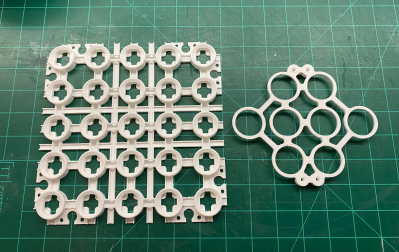Ping-pong balls have many uses: apart from playing table tennis, they have been used for countless art projects, science experiments, and even to raise ships from the bottom of the ocean. As it turns out, they also come in handy as diffusers for LED pixels, allowing the construction of large-size displays without requiring large individual LEDs.
[david] designed an LED ping-pong ball display using 3D printed components, which allows for the construction of arbitrarily-large LED displays thanks to a strictly modular design. The basic unit is a small piece that holds a single LED module and has a cup-like structure for attaching a standard table tennis ball. Twenty-five of these basic units combine together into a panel that also contains wiring ducts. Finally, any number of these panels can be combined into a display, thanks to clips that give the structure rigidity in the out-of-plane direction.

Of course, simply mounting LED modules is not enough to create a display: the LEDs also need to be connected to power and data lines. [david] didn’t relish the thought of having to cut and strip 1,800 pieces of wire, and therefore devised a clever way of automating this process: he put a bunch of wires onto a piece of card stock and used a laser cutter to burn off the insulation at regular intervals. Then it was simply a matter of soldering these wires onto the LEDs and snipping off pieces along the data bus.
The finished panel is driven by a combination of a Teensy 3.2 to generate the data signals and a Raspberry Pi to process the images. You can see the rather impressive result in the video embedded below; if this inspires you to build your own, you’ll be happy to hear that the STL files and all code are available on [david]’s project page.
Massive LED displays are always fun to watch, and although this is not the first one to use ping-pong balls as diffusers, its modularity and open-source design makes this one perhaps the easiest to replicate. Assuming you have a good supplier of ping-pong balls, of course.
















Does that display really draw 20A? (It could: 30*10 neopixels *0.06A = 18A)
And that 18A would be at full white. Maybe these are a different kind of pixel that draws more power? Or there are more pixels wired up that are not visible?
there’s a decimal after the 2 guys…. 2.xxx amps
What material are ping pong balls made from these days? It’s been a couple decades but I recall they were celluloid, that burned great!
this is what i came to say.
They are still nitrocellulose. The material is basically flash-paper slowed down by some percentage of camphor. They still burn very fast but not for long. Probably not legal for manufacturing use in lighting so be careful. The problem, if there is one, is you can’t predict how the circuits will fail. Setting fire to one of the module frames full off balls will be a nice test.
apparently they’ve been plastic since 2014. Definitely burned well – especially en masse.
If your LED panel generates enough heat to set things on fire, you have larger problems.
Neat. The diffusion of the ping pong balls acts as a primitive anti-aliasing.
Still, they should be dipped half in black paint with a hole in the bottom to stop light leaks and improve contrast.
@Dude said: “Still, they should be dipped half in black paint with a hole in the bottom to stop light leaks and improve contrast.”
Yes, and the paint can act as an adhesive to hold the ball in the frame after it dries.
It would probably be easier to increase the depth of the mount to cover more if the balls and print in a dark color.
Faster to put a glob of blue-tack on the ball and dipping it in paint.
This is brilliant! The wiring jigs are also cool. My only worry is the use of the laser cutter to strip the wires; are they not insulated with PVC a lot of the time?
“Assuming you have a good supplier of ping-pong balls, of course.”
Or save up the balls from your roll-on deodorant.
B^)
Those colors are so washed out, with the work lights off I’d be more impressed. Video doesn’t register like the eye to color and brightness the same way.
The earliest use of ping-pong balls must on be one of those Gen1 computers for the main display 0 thru 9 in a few rows. Decimal output not binary, wow. Digits were painted on the balls and probably a #47 lamp inside so the front is lit the best instead of like here.
Alternative: the globes on LED bulbs, however only a few available fat chance finding a supplier. They have great light diffusing effect and are more rugged at least this side of the pond. Clive’s teardowns have them being soft and squeezable over there.
Why would you paint the numbers on to ping pong balls when they could be painted directly on the indicator bulb?
Somebody brings BitLunis work on a new level. :D
How did you attach the ping pong balls to the 3D printed mounts? I also built a 1,200 ball display, but the ping pong ball material is slippery and the hot glue that I tried doesn’t adhere consistently. Thanks!
I think you could design the wiring channels to isolate the wires, then just run bare wire to each LED. Alternatively, you could cut up plastic or even paper soda straws to isolate the wires, and again, just run bare wire to the LEDs and slip an appropriate length straw over it as needed.
Could you get greater pixel density by setting the balls on hexagonal centers?
So when do we see someone play “Bad Apple” on one of these? (https://knowyourmeme.com/memes/bad-apple/videos)